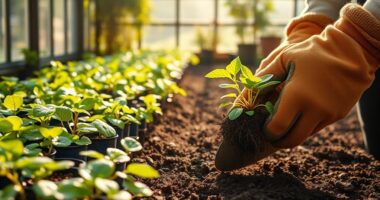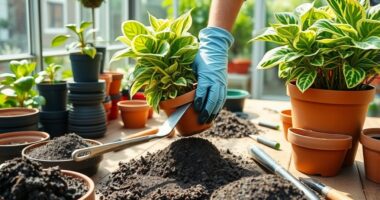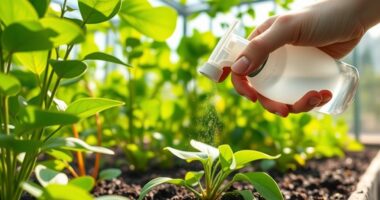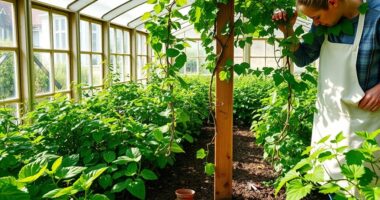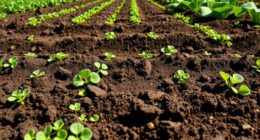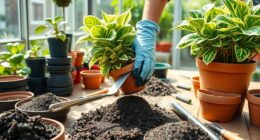To guarantee a bountiful greenhouse tomato harvest, focus on maintaining ideal soil conditions by testing and amending your soil regularly, with compost and proper drainage. Use mulch to conserve moisture and control soil temperature. Keep pests at bay by inspecting plants often, introducing beneficial insects, and using organic controls. Good air circulation and plant spacing help prevent diseases. By managing these factors carefully, you’ll maximize your tomato yields—discover more tips to boost your success.
Key Takeaways
- Regularly test and amend soil to maintain optimal pH (6.0–6.8) and nutrient levels for healthy growth.
- Apply mulch to conserve moisture, regulate soil temperature, and suppress weeds around tomato plants.
- Use physical barriers and beneficial insects to prevent pest infestations organically.
- Ensure good air circulation and proper spacing to reduce fungal diseases and pest attraction.
- Incorporate organic matter and rotate crops annually to improve soil health and prevent soil-borne issues.
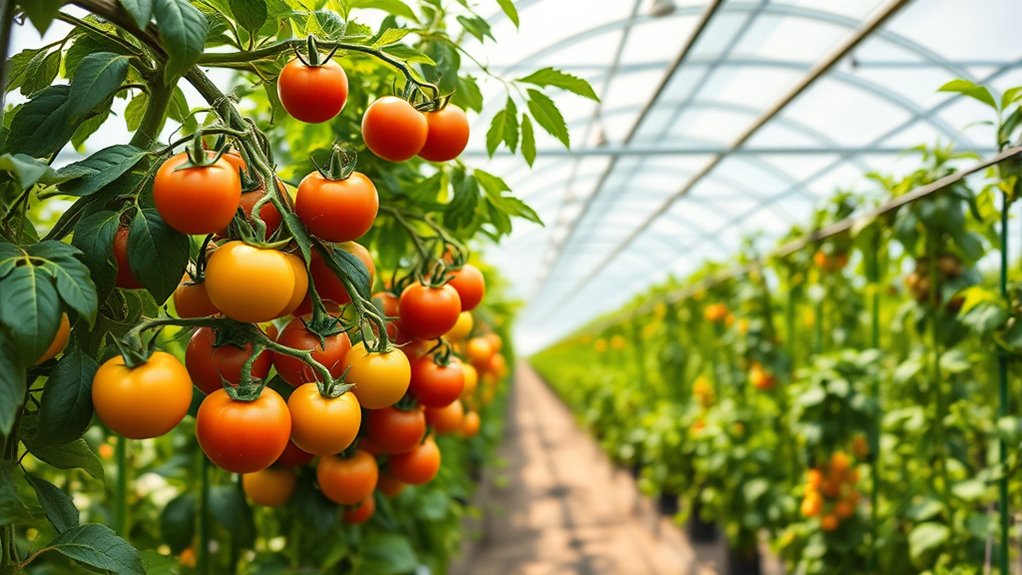
Growing tomatoes in a greenhouse offers you a controlled environment that extends the growing season and boosts yield quality. To maximize your harvest, you need to pay close attention to soil management. Healthy soil is fundamental for strong plant growth and high fruit production. Start by testing your soil’s pH and nutrient levels to guarantee ideal conditions; tomatoes thrive in slightly acidic soil, around pH 6.0 to 6.8. Incorporate organic matter like compost or well-rotted manure to improve soil structure, drainage, and fertility. Regularly amend your soil based on test results to prevent deficiencies and promote vigorous growth. Good soil management also involves rotating crops each season to prevent soil-borne diseases and reduce pest buildup. Mulching around your plants not only conserves moisture but also helps regulate soil temperature and suppress weeds, which compete with your tomatoes for nutrients. Soil health is a crucial factor in achieving a productive greenhouse tomato crop.
Pest control is another critical aspect of maintaining a healthy greenhouse tomato crop. The warm, humid environment of a greenhouse can attract a variety of pests such as aphids, whiteflies, spider mites, and tomato hornworms. To keep these pests at bay, begin with preventative measures. Use physical barriers like insect screens on vents and doors to restrict pest entry. Regularly inspect your plants for early signs of infestation; catching problems early makes control much easier. Introducing beneficial insects such as ladybugs and predatory mites can naturally reduce pest populations without chemicals. Keep your greenhouse clean and free of plant debris, as pests often hide in leftover leaves and stems.
In addition, consider using organic pest control options like neem oil or insecticidal soaps, which can be effective against many common pests without harming your plants or the environment. Be cautious with chemical pesticides, as they can disrupt your greenhouse’s delicate ecosystem and potentially leave residues on your fruits. Proper air circulation helps prevent fungal diseases and discourages pests from settling in. Maintaining ideal humidity levels and spacing your plants properly also make it harder for pests to establish themselves.
Combining good soil management with vigilant pest control creates a healthy foundation for your greenhouse tomatoes. When your soil is rich and well-maintained, your plants are naturally more resilient against pests and diseases. Regular monitoring, preventive strategies, and organic controls ensure that pests don’t get out of hand, allowing your plants to thrive and produce a bountiful harvest. Staying proactive in these areas will help you enjoy a successful growing season with minimal setbacks, leading to flavorful, high-quality tomatoes right from your greenhouse.
Frequently Asked Questions
How Do I Prevent Pests in My Greenhouse Tomatoes?
To prevent pests on your greenhouse tomatoes, start by regularly inspecting plants and maintaining cleanliness. You can introduce natural predators like ladybugs or lacewing flies to control aphids and other pests naturally. Additionally, use organic sprays such as neem oil or insecticidal soap to keep pests at bay without harming your plants. Combining these methods creates a healthy, pest-free environment, ensuring your tomatoes thrive and produce a bountiful harvest.
What Are the Best Varieties for Greenhouse Growing?
Ever wondered which tomato varieties thrive best in a greenhouse? Your variety selection depends on cultivar characteristics like disease resistance, fruit size, and growth habits. Opt for determinate types if you want a compact plant or indeterminate if you prefer continuous harvests. Cherry or heirloom cultivars often perform well indoors. Selecting the right variety guarantees your greenhouse yields are plentiful and high quality, making your gardening efforts truly rewarding.
How Often Should I Water My Greenhouse Tomatoes?
To keep your greenhouse tomatoes healthy, you should establish a consistent watering schedule, typically watering every 2-3 days. Use moisture monitoring tools, like a soil moisture meter, to check soil dampness and avoid overwatering or underwatering. Adjust your watering frequency based on temperature, humidity, and plant needs, ensuring the soil stays consistently moist but not soggy. Proper watering helps prevent diseases and promotes a bountiful harvest.
When Is the Ideal Time to Harvest Greenhouse Tomatoes?
Timing is everything when it comes to harvesting tomatoes; you don’t want to jump the gun or wait too long. Keep an eye on ripening indicators like color, sheen, and firmness to determine the perfect harvest timing. Usually, tomatoes are ready when they’re fully colored and slightly soft. Trust your senses, and don’t be afraid to pick them a bit early—sometimes it’s better to be safe than sorry.
How Can I Improve Pollination Indoors?
To improve pollination indoors, you should explore effective pollination techniques and consider indoor pollinator options. Gently shaking or tapping your plants can help spread pollen, while using a small brush or cotton swab allows for targeted pollination. Additionally, introducing indoor pollinators like bumblebees or using fan circulation mimics natural airflow, boosting pollination success. Consistently monitor and adjust these methods to maximize your tomato yields.
Conclusion
With the right care, growing greenhouse tomatoes can be as rewarding as harvesting a ripe apple from a tree. Keep monitoring temperature, humidity, and light, and don’t forget to water and feed your plants regularly. Stay attentive to pests and diseases, and your plants will thrive. Remember, patience and consistency are key—soon enough, you’ll be enjoying a bountiful harvest just like a chef savoring the perfect dish. Happy gardening!

